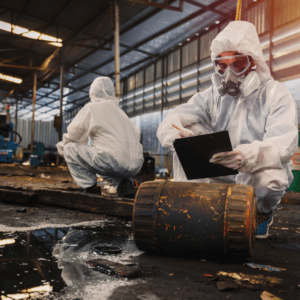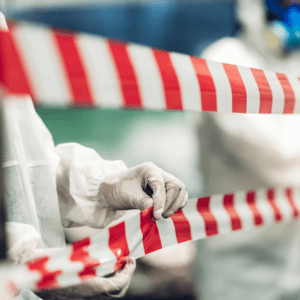Lead Dust Removal | How to Seal Off Lead-Contaminated Areas
Lead Dust Removal | How to Seal Off Lead-Contaminated Areas
Key Takeaways
- Assessment is crucial: Before sealing, conduct thorough testing to determine the level and concentration of lead contamination.
- Use appropriate materials: Select materials like polyethylene sheeting, duct tape, and specialised sealants that effectively create an impermeable barrier against lead dust.
- Follow a detailed process: The sealing process includes preparation, cleaning, applying sheeting, securing edges, and sealing openings to ensure complete isolation of contaminated areas.
- Safety first: Wear proper personal protective equipment and ensure that the area is well-ventilated during the sealing process to protect those involved from lead exposure.
- Regular maintenance and compliance: Maintain the integrity of the seal with regular inspections and comply with local and federal regulations to manage lead safely.
Summary
This article provides a comprehensive guide on effectively sealing off lead-contaminated areas to prevent lead exposure. It covers the importance of assessment, choosing the right materials like polyethylene sheeting and specialised sealants, and details a step-by-step sealing process. Safety precautions, regular maintenance, and compliance with regulations are emphasised to ensure a safe environment and adherence to legal standards.
Understanding the Importance of Sealing Lead-Contaminated Areas
Sealing off areas contaminated with lead dust is a critical step in preventing lead exposure, especially in environments where children are present. Lead is a toxic metal that can cause serious health problems if ingested or inhaled, particularly in young children who are more susceptible to its harmful effects. Effective sealing techniques can mitigate these risks and ensure a safer living or working environment.
Assessing the Contamination Level
Before beginning the sealing process, it is essential to assess the level of contamination. This involves conducting thorough testing of the area to identify the presence and concentration of lead. Professional testing services can provide accurate results and help guide the remediation process.
Choosing the Right Materials for Sealing
Selecting the appropriate materials is crucial for effectively sealing off lead-contaminated areas. Materials such as polyethylene sheeting, duct tape, and specialised sealants are commonly used because of their ability to form an impermeable barrier against lead dust.
- Polyethylene Sheeting: This is a plastic film used to cover and seal the contaminated area. It should be thick enough to prevent tearing during application.
- Duct Tape: High-quality duct tape is used to secure the edges of the polyethylene sheeting and ensure that no lead dust can escape.
- Specialised Sealants: These are used to treat areas that cannot be covered with sheeting, such as around windows and door frames.
Step-by-Step Guide to Sealing Contaminated Areas
- Preparation: Remove all furniture and items from the area to ensure thorough sealing.
- Cleaning: Vacuum the area with a HEPA filter vacuum to remove any loose lead dust.
- Applying Sheeting: Cover the floors, walls, and any other contaminated surfaces with polyethylene sheeting, extending a few metres beyond the contaminated area to create a safe barrier.
- Securing the Edges: Use duct tape to seal the edges of the sheeting to the floors, walls, and ceiling, ensuring that there are no gaps.
- Sealing Openings: Apply specialised sealants around any openings, such as windows and doors, that cannot be completely covered by sheeting.
- Final Inspection: Carefully inspect the area to ensure that it is completely sealed and no lead dust can escape.
Safety Precautions During the Sealing Process
Safety is paramount when dealing with lead-contaminated areas. It is important to wear appropriate personal protective equipment (PPE) such as gloves, goggles, and disposable coveralls. Ensure that the area is well-ventilated and that all workers involved in the sealing process are trained in lead safety protocols.
Maintaining the Seal
Once the area has been sealed, it is important to maintain the integrity of the barrier to prevent future exposure to lead dust. Regular inspections should be conducted to check for any breaches in the seal and repairs made as necessary.
Legal Requirements and Compliance
Understanding and complying with local and federal regulations regarding lead safety is crucial. This includes following guidelines for the disposal of lead-contaminated materials and ensuring that all sealing activities are carried out in accordance with the law.
Hiring Professional Lead Dust Removal Services
Hiring professional lead dust removal services is crucial due to the hazardous nature of lead, which requires specialised knowledge and equipment to handle it safely. Professionals are trained in effective methods that adhere to stringent health and safety regulations, ensuring that lead is thoroughly and safely removed from the environment. This not only minimises health risks, particularly in spaces inhabited by children who are most vulnerable to lead poisoning but also ensures compliance with legal standards, protecting property owners from potential liabilities. Their expertise helps in accurately assessing the extent of contamination and implementing the most effective remediation strategies, thus providing peace of mind that the removal process is conducted correctly and efficiently.
Sealing off lead-contaminated areas effectively requires careful planning, the right materials, and strict adherence to safety protocols. By following the steps outlined above, property owners and contractors can ensure that they are taking the necessary precautions to protect individuals from lead exposure and comply with regulatory standards.
FAQs
How do I know if my property needs lead dust removal?
To determine if your property requires lead dust removal, you should conduct a lead inspection and testing, particularly if your home or building was constructed before the 1980s when lead-based paints were commonly used. Testing is also crucial after any renovation or disturbance that could have exposed lead-containing materials.
What methods are used for lead dust removal?
Professional lead dust removal often involves a combination of methods, including wet cleaning to prevent dust dispersal, HEPA vacuuming to remove fine particles, and sometimes, chemical stripping or encapsulation of lead-based paints. The specific approach depends on the extent of contamination and the nature of the affected surfaces.
Is DIY lead dust removal safe?
DIY lead dust removal is not recommended due to the significant health risks associated with improper handling and removal of lead-containing materials. Professional services are equipped with the necessary tools, safety equipment, and expertise to ensure lead is removed safely and in compliance with regulatory standards, minimizing the risk of exposure to occupants and workers.
Why Choose Us?
AllAces Cleaning & Restoration has over 35 years of industry experience handling extensive lead dust removal projects across Brisbane, Sydney, Melbourne and surrounds. Our highly trained and certified technicians utilise the latest technology and equipment to ensure the return of a pre-loss condition.


